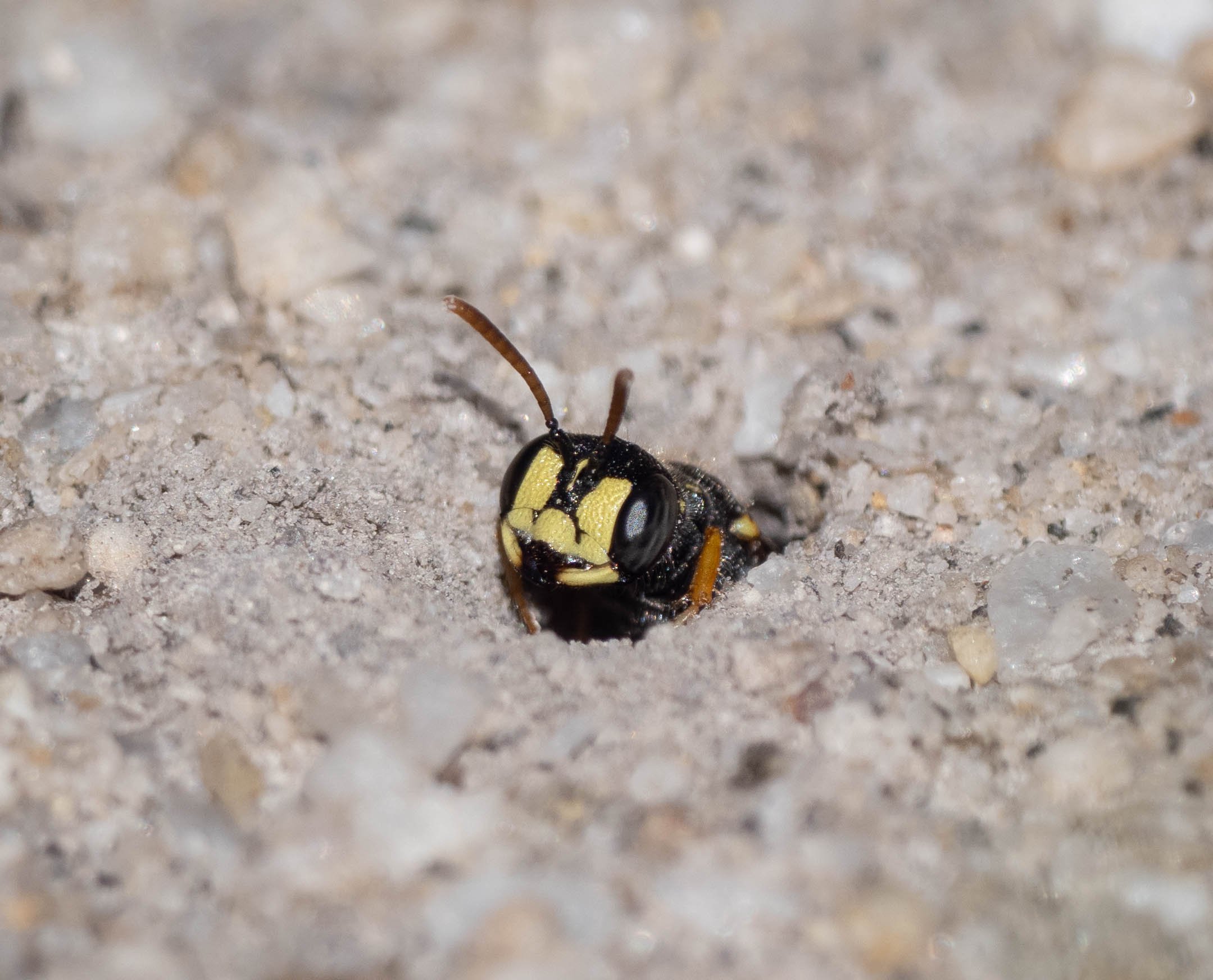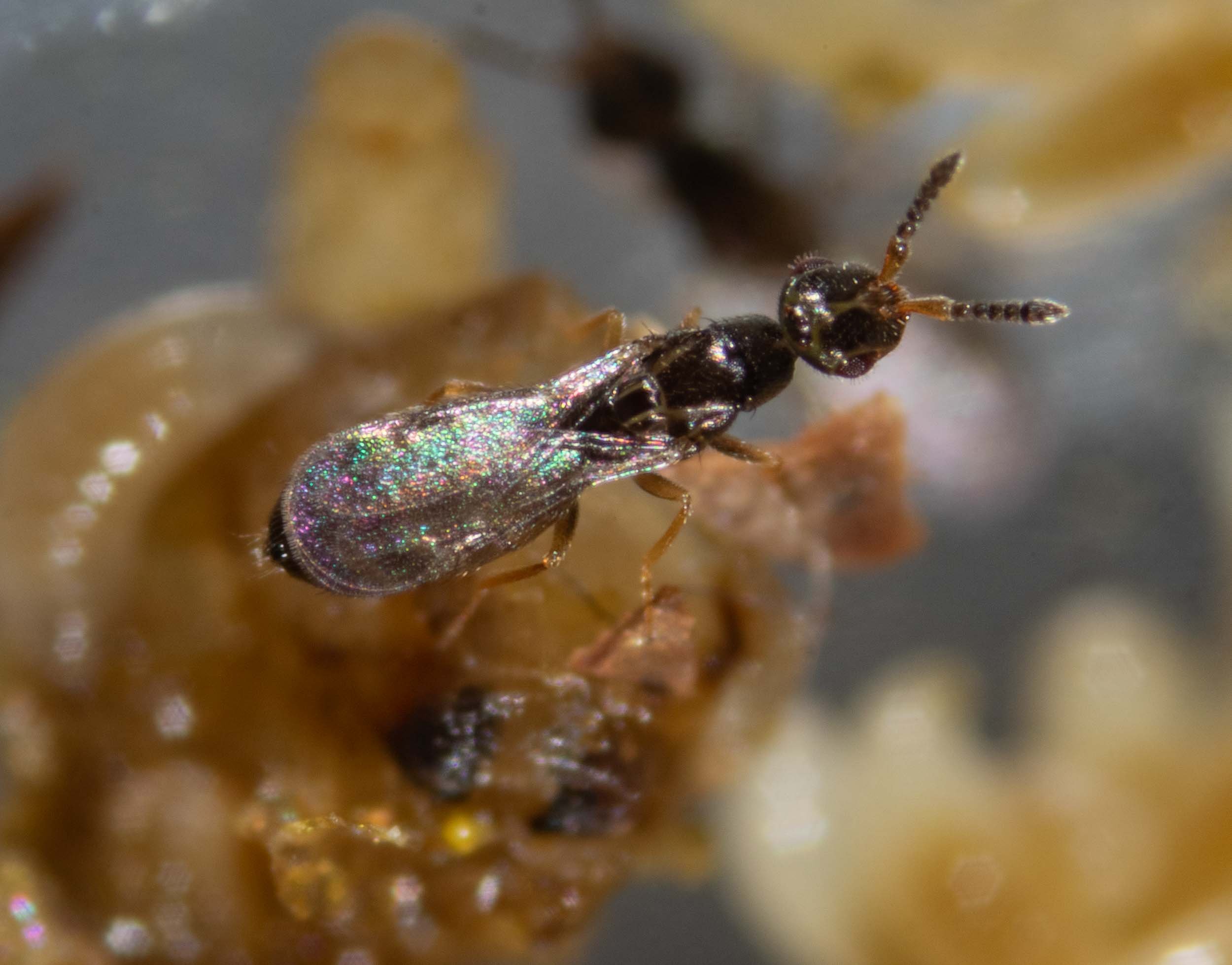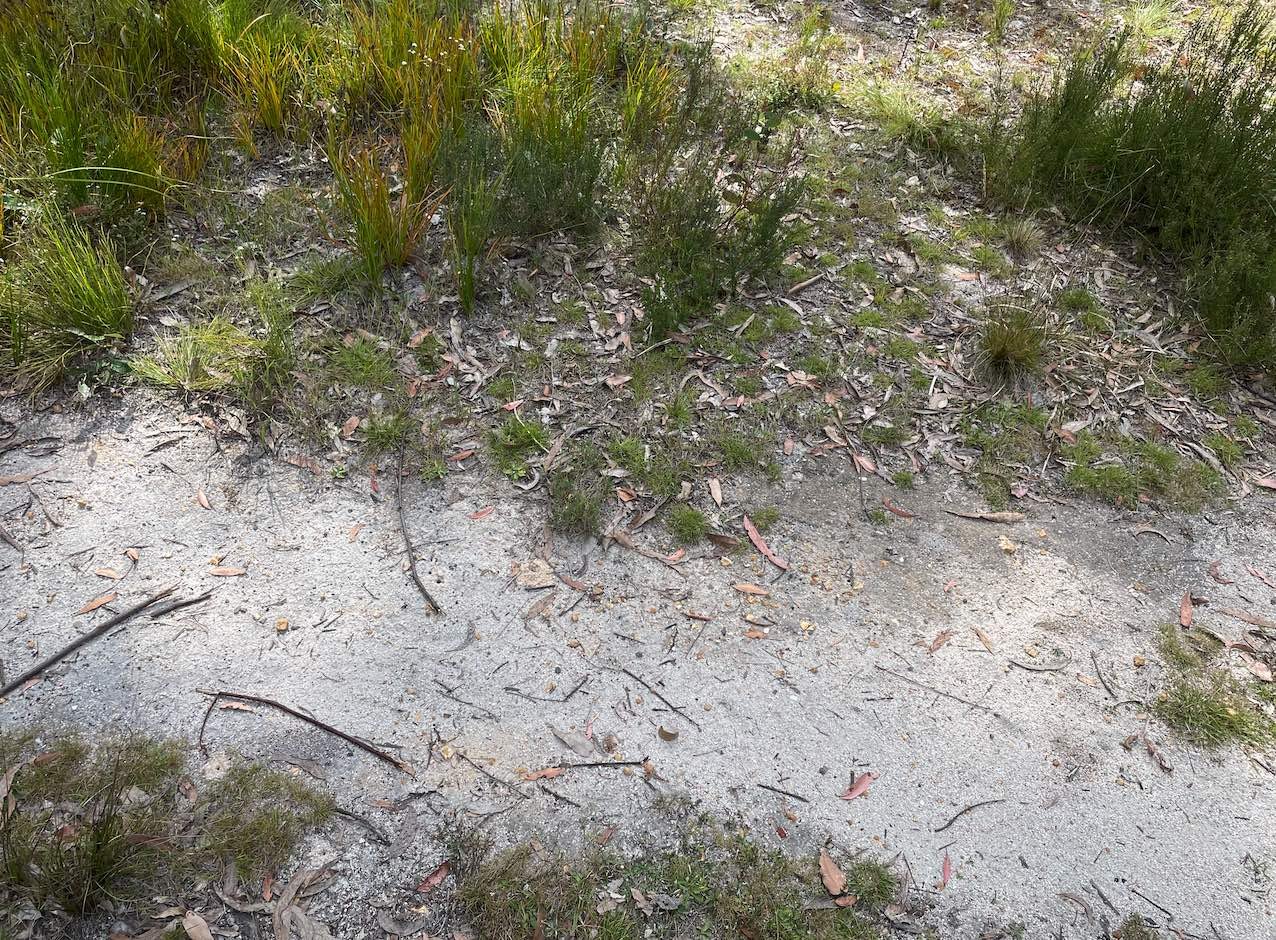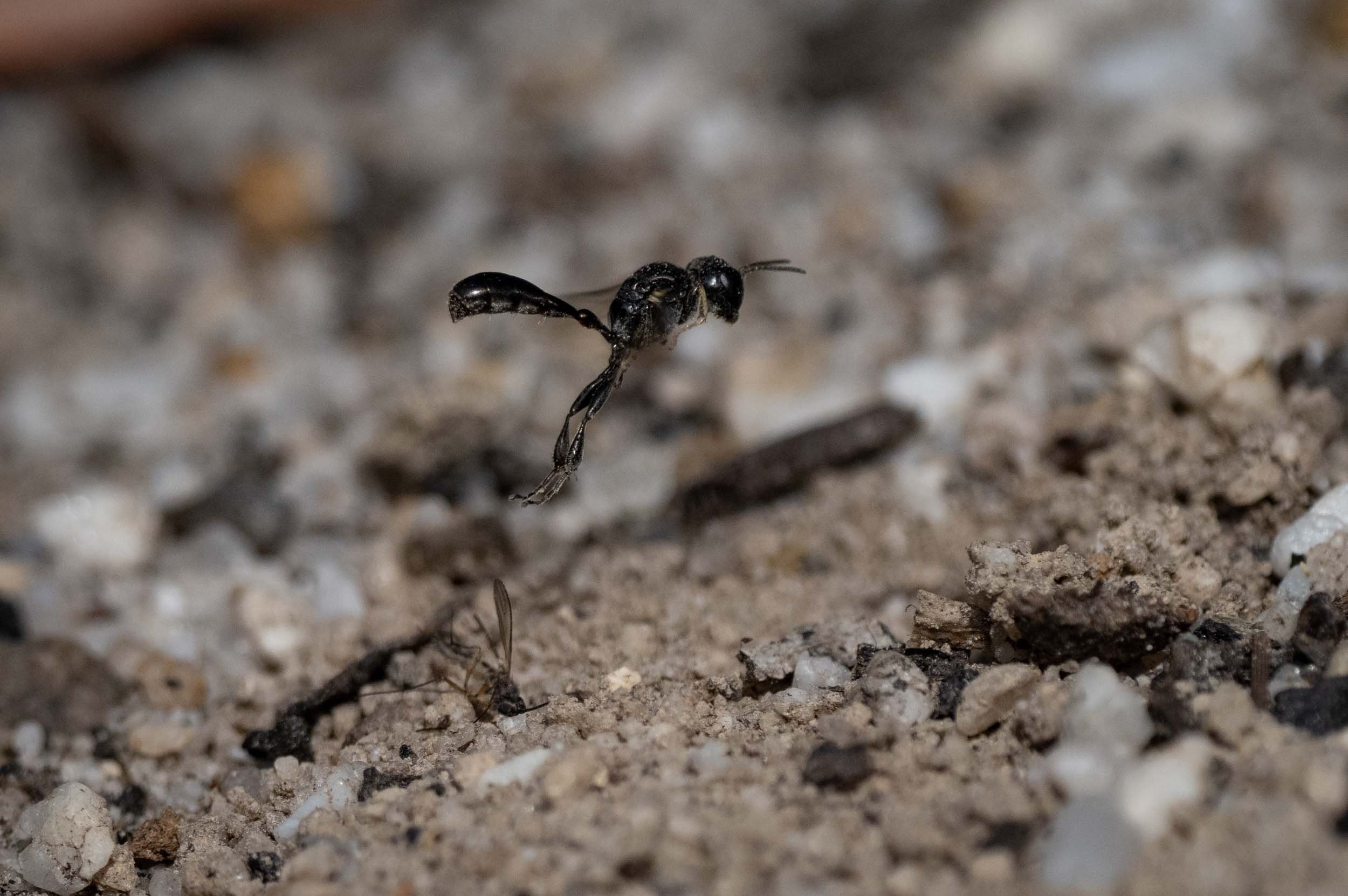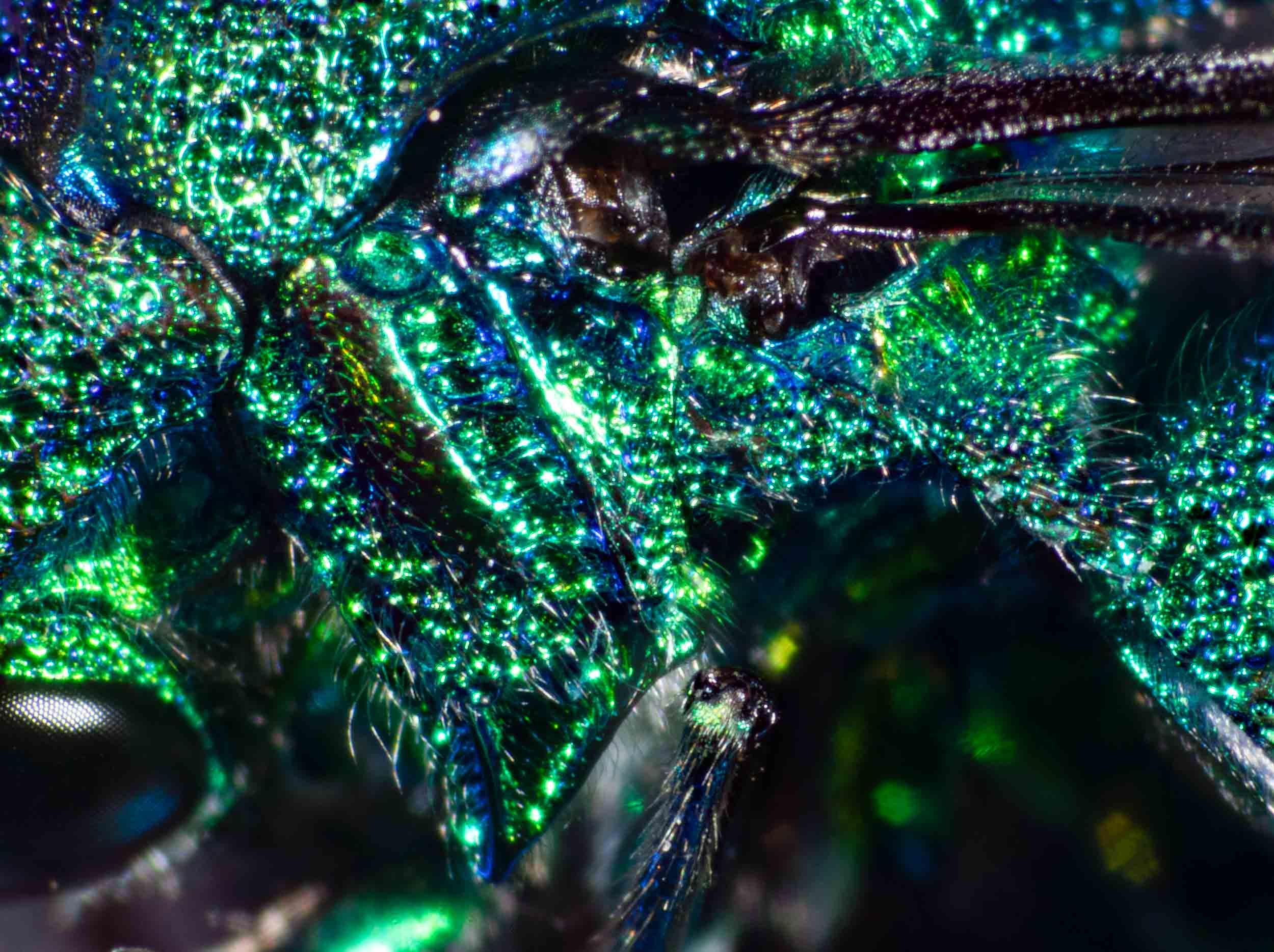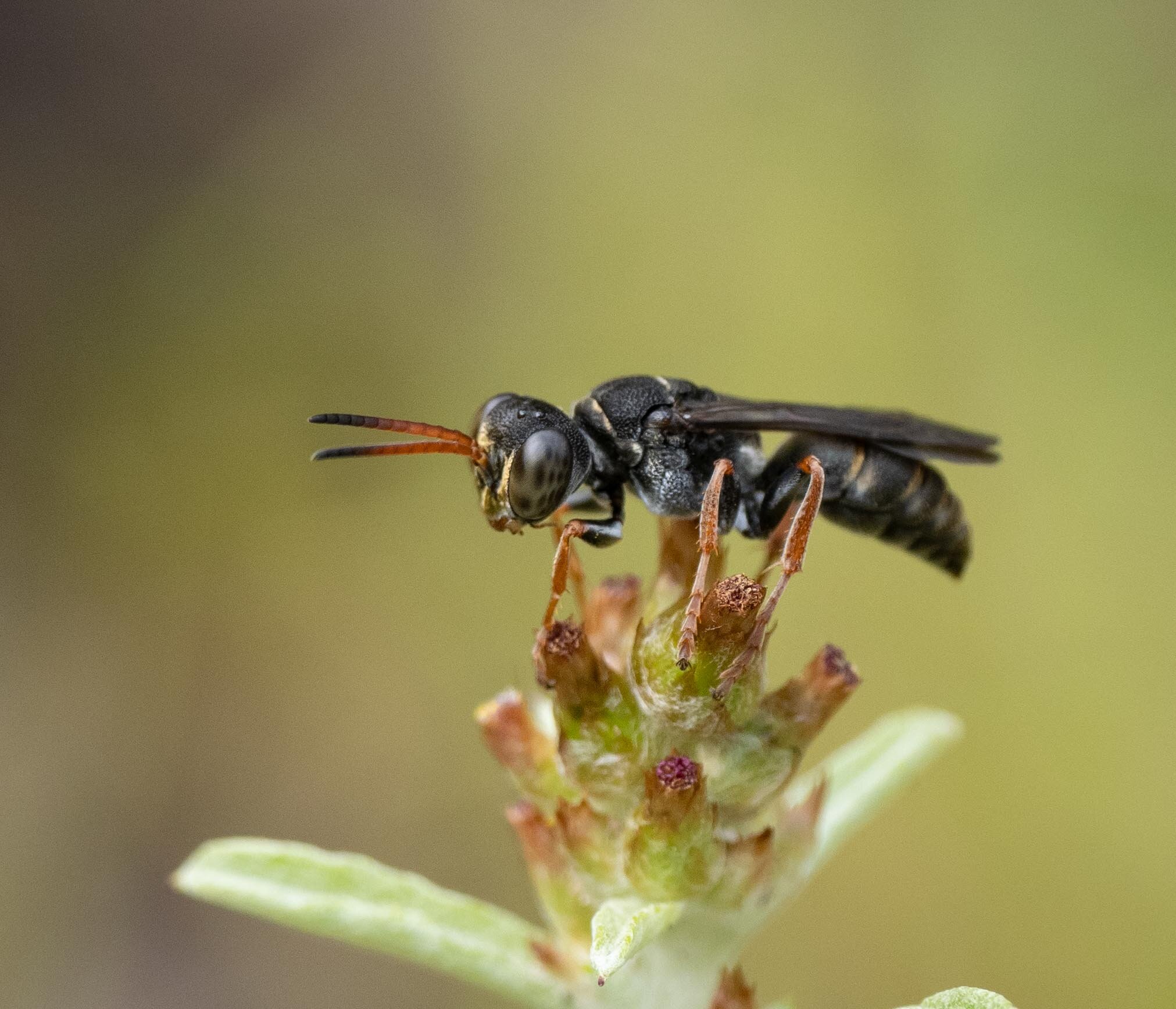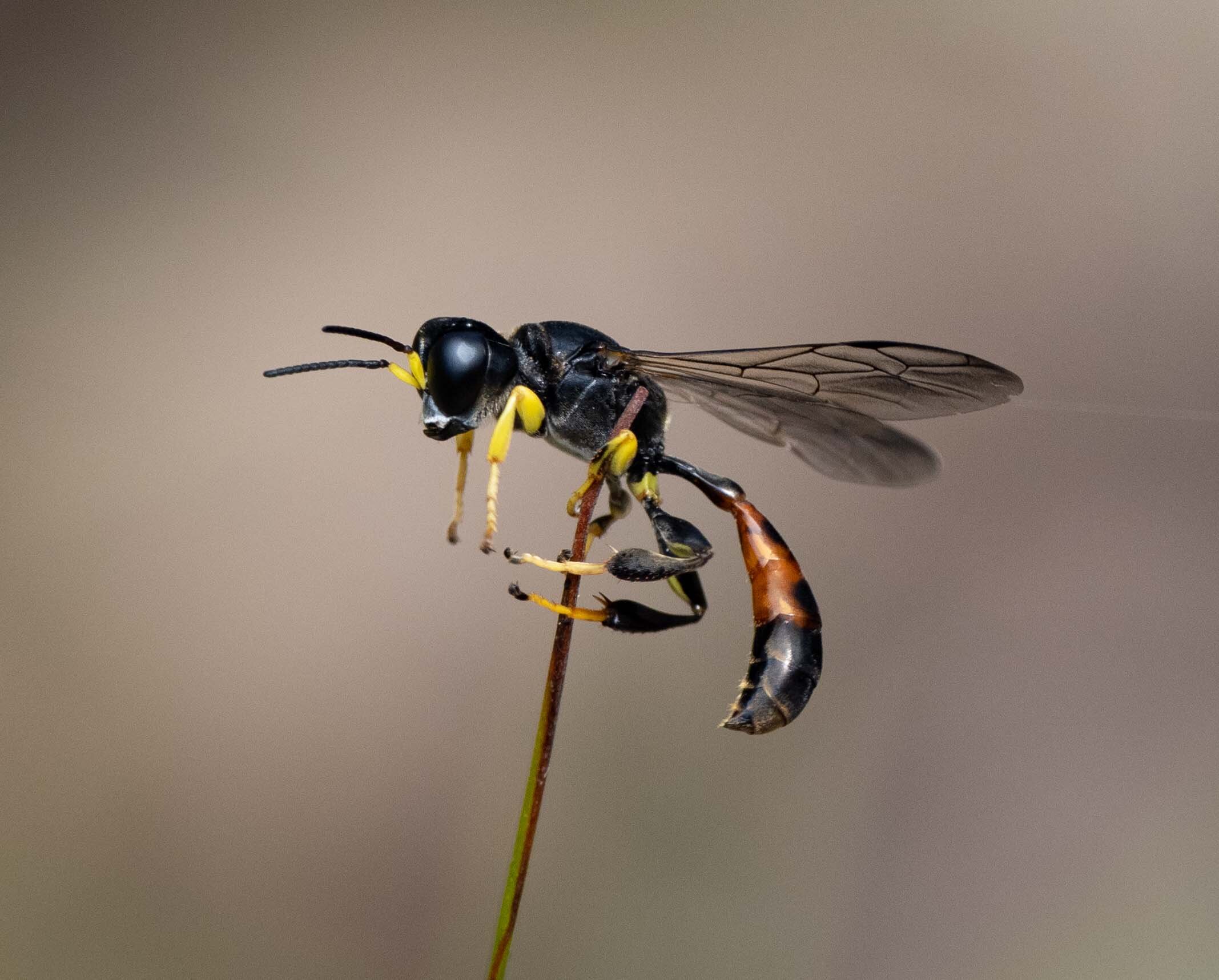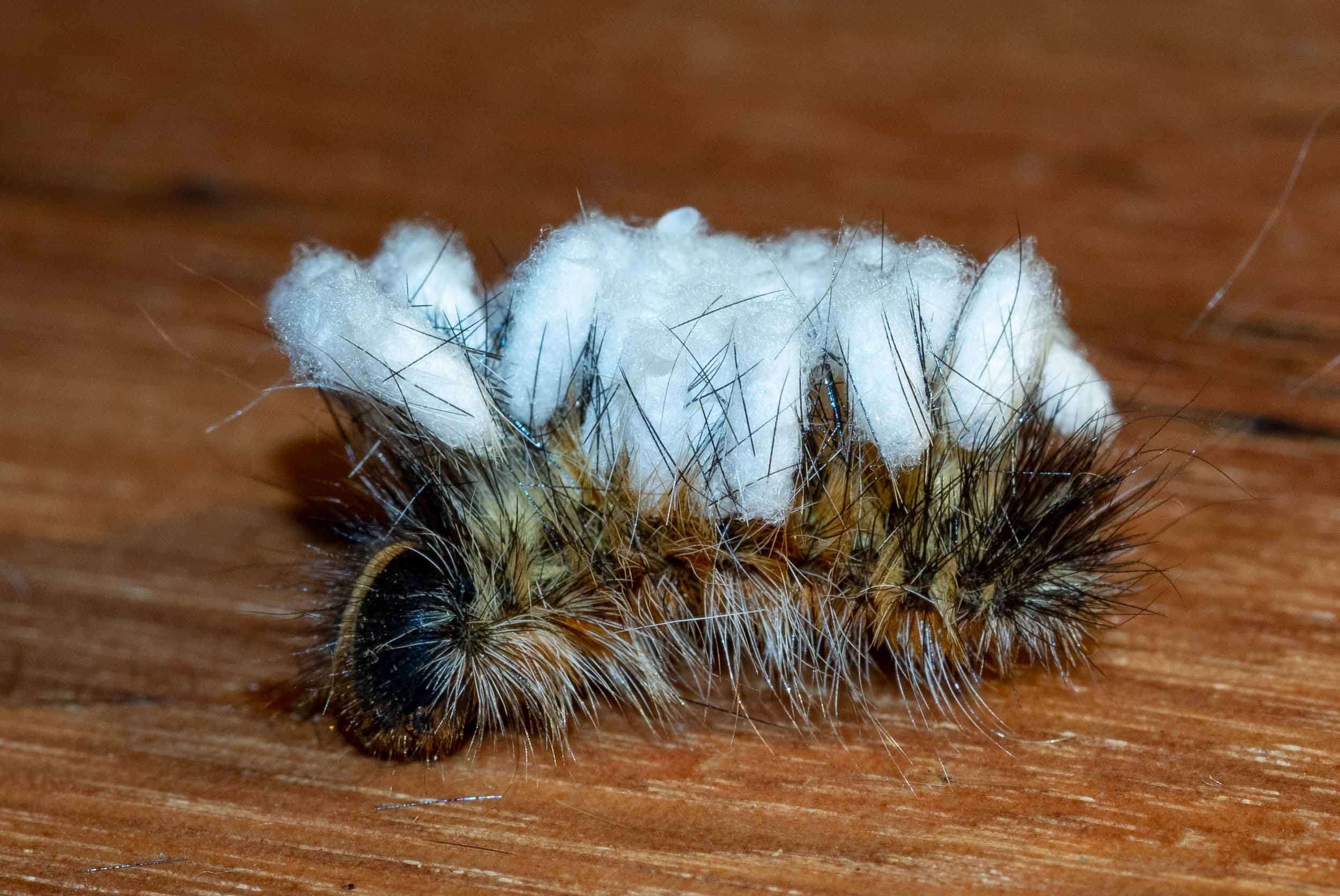Wasp Week
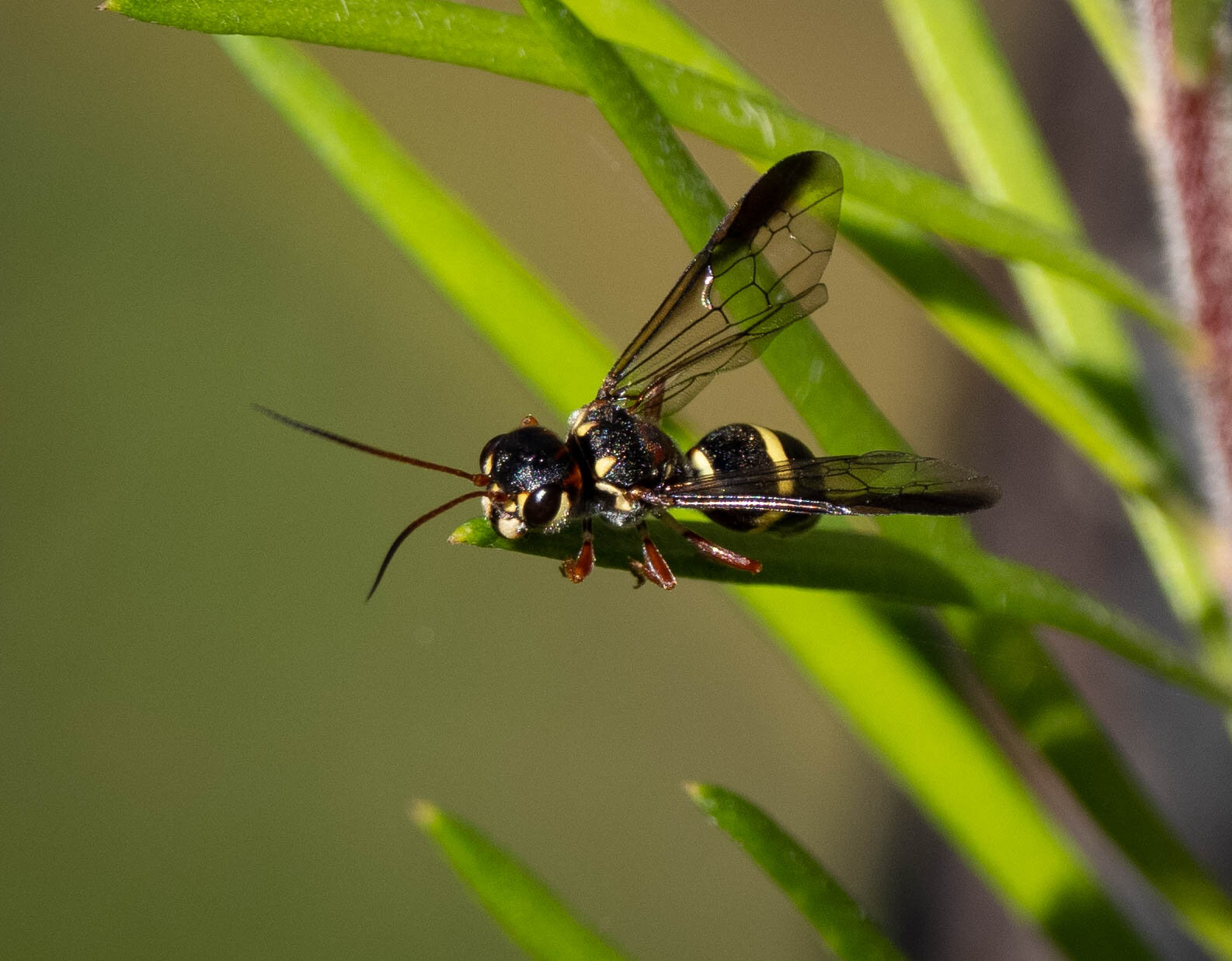
Late Autumn, light winds, warm sunshine, lush undergrowth … and wasps! Lots of them. In all shapes and sizes. So this week I’ve taken up wasp spotting. Again. Happily.
Apart from a few infamous species, most wasps are invisible and unknown to the casual observer. They’re either too small, too fast-moving, or too rare to catch attention. Yet they are arguably the most fascinating insect group … and that’s saying something! Some are predators, some are parasites. Some are social, most are not. Some build nests of mud or wood-pulp, some dig burrows or occupy spaces created by others. Yet many – the parasites of free-living insects – use no nests at all.
This week I’ve taken to sitting for hours in one small patch of the forest, on alert, camera in hand. With the sun shining and no wind, I spot moving insects everywhere. The very tiny and the very fast escape, yet the diversity of wasps I’ve been able to capture (with my lens) has amazed even me. Wasps from at least 12 different families, variously hunting, laying eggs, building nests, or generally hanging about in the sun.
Although I can’t yet identify all of them, I’ve photographed around 20 species. And of course there are many, many more – tiny ones that I’ve no hope of successfully catching with my camera, even if I can see them. All this wasp activity in one small patch of forest, at roughly the same time … astonishing.
It is not simply the number of species that surprises me, it is the variety!
First, as background (and extra detail, for the super-keen) here’s a summary of Australia’s wasp species, by taxa.
This week’s collection includes wasps from eight quite disparate superfamilies – nearly half of Australia’s 17 superfamilies. They are diverse in terms of evolutionary history, appearance and biology: flower wasps (Thynnidae), so familiar from early Summer (see my October blog); long-legged spider wasps (Pompilidae); social paper wasps (Vespidae); parasitic wasps with their long ovipositors (Braconidae & Ichneumonidae); and more.
Apart from the wide variety this week, the biggest thrill came from spotting unusual wasps from small taxa – including one that is quite rare.
Trigonalidae is a family that I’ve never even heard of before. By all reports, these wasps are seldom seen and only a few species have been studied in detail. And what is known is quite extraordinary. They lay eggs on leaves and rely on caterpillars to eat the leaves. But not just any caterpillar … ideally one that already has been parasitised by some other insect!
The second significant sighting was the little ‘cockroach wasp’, Ampulicidae. Although I’ve never seen one of these before either, I did recently read about their rather unique prey capture technique. They subdue their prey without completely immobilising it. The wasp sting just confuses the cockroach so that it allows itself to be led back to the site of its eventual demise. Clever trick when your prey is usually much larger than you are!
At this point I’d like to acknowledge the global naturalist community for helping me identify both the Trigonalidae and the Ampulicidae. I had no clue what they were, but put the sightings up onto iNaturalist and was quickly pointed in the right direction. Thanks folks!
More about Trigonalidae
The biology of Trigonalidae is unique among parasitic wasps (ref 1, 2). While other species seek out their hosts in some way or another, trigonalids simply lay huge numbers of eggs on foliage – on the off chance that a leaf-eating insect will come along and consume them. And the story goes further, in that most trigonalids seem to be ‘hyperparasites’. The ingested eggs hatch in the gut of the primary host … usually a caterpillar … but the little parasites are rarely interested in consuming the primary host. They are looking for parasites of other insect species (wasps or flies) already inside the caterpillar! Although there are variations on this theme, and for most species of trigonalid nothing is known at all, this bizarre method of reproduction seems quite common across the family.
Despite their intriguing biology, world-wide distribution and relatively large size (5-15mm long), trigonalids are rarely photographed and the biology of most remains a mystery. This has been attributed to their “sporadic occurrence and short-lived adult stage” (ref 2, p400). How lucky I am –I’ve been watching them all week!!
The sightings below tell some of their story. Different individuals are labelled a-d.
A single species? They are so varied in colour!
Different females may have very different colouration – is this likely within a single species? My first thought when I noticed this was that perhaps, against all odds, I was seeing two species of trigonalids visiting the same bushes, at the same time. Extremely unlikely, yet one has such prominent red markings. Most curious.
One explanation is that the black colour develops over time. Perhaps female 2 has emerged only recently. That could be, but there is a second possibility. Upon further reading, I found the following statements:
“The size of adult trigonalyids is known to vary with the size of the host it has developed upon ….
Specific characters are also variable, and adult Bareogonalos jezoensis (Uchida) reared from Vespula look specifically different from those reared from Vespa.” (ref 2, p 401, citing Matsuura & Yamane, 1984)
So now I’m assuming that the two females above are indeed a single species, but that they spent their larval lives in quite different types of insect hosts. Yet more variation (and mystery) to throw into this week’s variety show.
Choosing plants for egg-laying
The trigonalids were laying on Acacia terminalis, a wattle species that has flourished here since the fire. Trigonalid species are known to be opportunistic, laying eggs on a wide variety of plants and parasitising a wide variety of hosts (ref 2). However, in a given area they do tend to visit just a single plant species. That report accords with my observations. Acacia terminalis was the only plant I saw the wasps using, despite there being another wattle species and various other plants in the same small patch.
We know from previous observations that many different species of caterpillar feed on Acacia terminalis. Perhaps a few of those will be parasitised by an ichneumonid wasp or a tachinid fly, and perhaps they’ll go on to eat a leaf containing trigonalid eggs. If so, we may see these rather special little wasps take flight again next year.
What were all the other wasps up to?
Working out who’s who amongst the wasps not only provides insight into local biodiversity – it also helps me make sense of what I’m seeing as I watch them. Here are my notes.
Gasteruptiidae: a female seeking the nests of bees or wasps to parasitise
These slender bodied, parasitic wasps are a reasonably common sight in the forest. We typically see them in bobbing flight around tree trunks, extremely long ovipositor, dangling legs, and clearly on the hunt. This one was investigating a burnt log … and it seems she had found something of interest.
She’s seeking the nest of a bee, apoid wasp (like Crabronidae) or vespid wasp (Vespidae), into which she’ll lay her eggs. Her larvae will consume both the host larva and its food store – be that the bee’s pollen or the wasp’s paralysed prey. She’s a kleptoparasite.
Ampulicidae: a diminutive hunter of cockroaches, large and small
It was on this same log that I spotted the little cockroach wasp. She’s a predator and was no doubt hunting cockroaches in the cracks of the log and amidst surrounding leaf litter. She doesn’t make a nest but rather leads her stung and placid prey to a nearby crevice, stings it again, lays an egg and departs.
Chalcididae: a small parasite of moths and butterflies, seeking late-stage caterpillars or pupae
This tiny wasp was moving from leaf to leaf, but then stopped for a bit of preening – rubbing her huge hind legs against her wings. Chalcid wasps are typically parasites of lepidoptera, laying their eggs into the pupae or late stage larvae of moths and butterflies. She probably uses her legs to grib the pupa during egg-laying - the swollen femora has an inner row of spines (arrow in third image).
Mutillidae: males on the lookout for wingless females, parasites of ground-nesting bees and wasps
Male velvet ants were a rather common sight this week, but I didn’t spot any females. The rather hairy males were generally perched on low vegetation or sticks, in the sun, preening themselves. Finding a mate is quite a challenge for these males. The flightless females might emerge from the soil or low tree trunks anywhere in the forest, and at many different times of the year. Males fly across the forest, low to the ground, following airborne chemical cues emitted by receptive females (ref 3).
Velvet ants are nest parasites. Females search the ground or tree trunks for the nests of bees or wasps, typically Apoidea, Sphecidae and Vespidae. The velvet ant enters the nest, protected by her strong cuticle and potent sting, and lays an egg alongside each host larva or pupa. The mutillid larva eventually kills its immobile host, then pupates safely within the nest.
Chrysididae: a kleptoparasite, this female on the hunt for the nests of solitary wasps
Cuckoo wasps are often brilliantly coloured and so are among the most popular of wasps. Among photographers that is, not fellow wasps.
They are kleptoparasites, taking advantage of the nest and contents of predatory wasps. The cuckoo wasp larva consumes the young host larva and then gradually consumes the food store provided by the host. Primochroeus (the genus to which our local species belongs) commonly sneak into the nests of mud-building wasps such as Pison and have evolved an effective defence against the stings of defending hosts … they can curl into a ball, exposing only their extra strong cuticle!
Crabronidae: collecting mud for nesting material and hunting spiders or insects
Wasps in this family are predatory, hunting free living spiders or insects upon which to raise their larvae.
Crabronidae are solitary wasps and I find them quite fascinating – you might recall my early Summer obsession with digger wasps. They are called digger wasps because many do indeed excavate burrows for nests. Some, however, use pre-existing cavities or build free mud nests … as does Pison, above. Pison hunt spiders, while Tachysphex prey on grasshoppers, mantids and cockroaches.
Pompilidae: various females hunting large spiders or collecting mud nest building
Pompilids are specialised spider hunters – hence the common name ‘spider wasps’. I didn’t see any spider-hauling, but the three species of spider wasps I spotted were all females engaged in hunting or nest-building.
In contrast to Pison (Crabronidae), which supply each larva with many spiders from various families (ref. 5), each cell of a pompilid nest contains one spider and one larva. As pompilids are typically quite large wasps, they need to hunt correspondingly large spiders. It is not uncommon to see a pompilid hauling a paralysed huntsman, legs nipped off for convenience of transport.
Thynnidae: winged males seeking the flightless females, often successfully
Flower wasps are another group I became fascinated by late last year. At that time, they were everywhere, in all shapes and sizes. There are still a few around, and they’re breeding, but in nothing like the numbers or diversity of Spring.
Thynnidae are hunters but unlike pompilids, crabronids, or other predatory wasps, you never get to see them hunting. The females are flightless and they do all their searching, prey capture and nesting underground. Some are known to prey on beetle larvae, particularly scarab beetles, but the life history of many flower wasps is unknown.
What you do see are males in search of females and, surprising often, mated pairs. Mate ‘capture’, feeding and mating is quite protracted, so I suppose I should not be surprised that it is so easy to catch them in action.
Ichneumonidae & Braconidae: parasites of free-living caterpillars and grubs, seeking hosts or mates
I’m grouping these two wasp families for several reasons. They are closely related (grouped into the superfamily Ichneumonoidea) and they have much in common in terms of their life cycle (all are parasitic or hyperparasitic). Collectively they’re a very large group (comprising around 14 per cent of Australia’s wasps) and are particularly common in south-eastern Australia. And they look similar enough that I’m not always confident to which family an individual wasp belongs.
Ichneumonids and brachonids lay eggs on or inside caterpillars, grubs, and other insect larva, while some parasitise spiders or spider eggs. The ‘Wonboyn Wasp’ (remember that one?) is just such a wasp, a tiny braconid using caterpillars as a larval host. The ones I’ve been photographing this week, however, have been considerably bigger than the tiny Cotesia wonboynensis!
The attractive white-spotted ichneumonid Echthromorpha intricatoria is particularly abundant in the forest at the moment. They’re a common sight flying about among the undergrowth. They perch on vegetation to preen, but more typically the females immediately move down to the ground. They are clearly searching, antennae flicking rapidly as they poke about amongst the leaf litter. Based on my reading, I assume that they are seeking butterfly pupae. Butterflies in the family Nymphalidae in particular … so it’s likely that the Common Brown (Heteronympha merope) will be on the menu. Common Browns have been the most numerous nymphalid in late summer, and the caterpillars pupate at the base of their host plants, native grasses such as Microlaena, Poa and Themeda.
When I see wasps like the one below, I think ‘braconid’. They seem to come in every possible combination of colours orange, black and white. Many brachonids have very long ovipositors. This might look like a dangerous ‘stinger’ but it lacks venom. Rather it is used to probe or bore into the concealed homes of their targets, typically beetle grubs, and to lay eggs onto or inside the larval hosts.
Vespidae: social hunters, but now having left their colonies to mate and hibernate
This family includes nearly all the truly social wasps. That is, wasps that form colonies with a division of labor between queens and workers, that care for the brood, and have overlapping generations. Both vespids I spotted this week are indeed social wasps and both are new arrivals in our forest. But only one is at all welcome!
First, we (somewhat hesitantly) welcome Ropalidia to our home list. Why the hesitation? This native species is known to form massive aggregations … swarms of multiple colonies, with multiple queens … all in one place. Such large colonies must have an impact on the local ecosystem. Intriguingly, such aggreggations are unique to our part of the south-east coast (ref 6). Further north along the coast, and also around Canberra, colonies are more discrete.
Ropalidia and other paper-wasps such as Polistes prey upon caterpillars. They tend their larvae throughout development, feeding them chewed up food. Quite a contrast to the stock-and-forget mode of childcare exhibited by pompilids and crabronids!
Now, to the really bad news. We also have European Wasps. Vespula germanica first appeared here in Spring 2020 and, despite our best efforts at eradication, their numbers grew throughout the Summer. And they’re not just here. European Wasps are being reported throughout the region, in many places they’ve not been seen before.
We live in hope that the European Wasps will disappear once the forests recover from the disruption of the fires. They are quite a disaster, ecologically. All we can do is hope. And destroy every nest we find. Carefully, as they are rather famously aggressive.
References
Carmean, D. & Kimsey, L. 1998. Phylogenetic revision of the parasitoid wasp family Trigonalidae (Hymenoptera). Systematic Entomology 23, 35-76
Weinstein, P. & Austin, A.D. 1991. The host relationships of trigonalyid wasps (Hymenoptera: Trigonalyidae), with a review of their biology and catalogue to world species. Journal of Natural History, 25, 399-433
VanderSal-Jensen, N.D., Crews, S.C. & Gillespie, R.G. 2016. Is love in the air or at first sight? Mate finding cues used by sympatric male velvet ants (Hymenoptera: Mutillidae). Invertebrate Biology, 135(3), 200-210.
Cuckoo Wasps fact sheet, Western Australian Museum (link)
Evans, H.E., Matthews, R.W. & Hook, A. 1980. Notes on the nests and prey of six species of Pison in Australia (Hymenoptera: Sphecidae). Psyche: A Journal of Entomology, 87, 221–230
Saito, F. & Kojima, J. 2005. Colony cycle in the south-eastern coastal populations of Ropalidia plebiana, the only Ropalidia wasp occurring in temperate Australia. Entomological Science, 8. 263-275
Plus, as always, Insects of Australia, 2nd Edition. 1991. CSIRO Publishing, the Australian Faunal Directory website …. and a little bit of Wikipedia thrown in.











































































